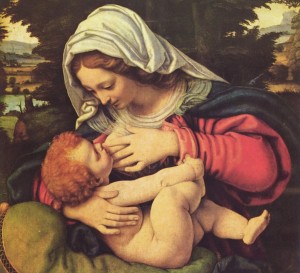The Divine Drool and the Art of Baby Worship
 This might be heretical, but give it a chance. God hasn’t struck me dead yet.
This might be heretical, but give it a chance. God hasn’t struck me dead yet.
Walking out of church this morning, a couple of days before Christmas, I happened upon a typical church foyer scene. As two older adults chatted near the door, a vaguely confused little boy of about two years stood looking around him. While certainly what you’d call cute, this blond-headed boy notably lacked, well, comeliness. His mother had stuffed him into a colorfully mismatched outfit and one tiny hand grasped a large, obnoxiously plastic sippy cup. On his chin was streaked a broad smear of saliva, as well as other substances.
As someone who grew up with almost no exposure to people younger than myself, the Small Things are still a category for which my worldview has no very solid explanation. This morning I passed through his grave gaze and pondered again, as many times before, these strange, knee-high alien phenomena.
At first, I spent my encounters with children trying to decipher their thinking, what the world means to them. But recently I’ve been more interested in what they mean to the world – how the sophisticated world reacts to the Small Things.
Why are they here? What do they want from us? And why do they always need their noses wiped? Cultures across time and space answer in many ways, and their answers say much about them.
Many catch on to the fact that Small Things usually become something useful in about 18 years or so, and for that reason should be indulged with relative safety. Unfortunately, many other cultures – noticing their sheer inconvenience and perceived overabundance (they have a way of popping up in unreasonable places) – have wound up viewing them as something quite plainly inviting disposal at will. We in the pro-life movement are sadly all well enough aware of that. But for the most part, the world naturally seems to say: you’re cute at times, but please don’t get in the way of the important things. Run along now.
I speak in a broad scale. In an intimate scale, of course, the exact opposite has always been true, because where there are babies, there are mothers. Yet the mother’s wisdom of what the Small Thing means remained inward-turned, hushed under roofs governed by more powerful forces, being after all an intimacy with weakness itself. Society-building has little use for such weakness, except as an inevitable hurdle in acquiring future society-builders.
Well, you know what this is leading up to. The weirdos crashed the scene a couple thousand years ago and have been pushing their baby-worship ever since, particularly around this time of year. We started making statues of babies, of a mother holding a baby, of babies dressed in resplendent robes, et cetera, et cetera. Suddenly the ancient oogly-baby-talk of mothers everywhere found its way into liturgy, theological works, philosophy … everything.
Somehow, they said, God took one look at the Small Thing and said with a boom, I want in on that. Of all the things that God created in the entire cosmos, the kind of thing He most identified with was the one that could drool happily on the shoulder of a poor young Jewish girl he wanted to call Mom.
Yet some may still take the Incarnation with the first view I mentioned: Christ became a baby so that he could eventually grow up and do useful things. I’m not denying He did do quite helpful things as an adult, but these people, I suspect, like to dwell on Christ only as a dignified, kingly-looking grown-up, or at the very least a softly-glowing baby with graceful fingers raised in solemn blessing.
Here’s all I want to say, and I think it’s directed mostly to people like myself, people with little experience of children, who must approach the Christmas miracle from the outside. The very truth of babies, of toddlers, is a humiliating thought. They just plain need help. They need diapers, their cheeks wiped, the breast offered them. It’s embarrassing to think about all the help we needed when we were that young. Similarly, when we think about the ageless God that young, we don’t want to feel embarrassed, thus we don’t want to consider these aspects of His royal Babyness.
But for those of us who view the universe as Christocentric, the Christ Child was not an afterthought to babyhood, but its very purpose. Because of such airbrushing, we allow ourselves to ignore just how excruciating was the Divine condescension, and in turn, fail to plumb the mind-boggling fact that every drooly, whimpering little face we see is, in a way, the exact location in the universe where humility – and thus God – is most concentrated.
Imagine if the whole world knew this. Wherever it saw a child like the one I saw in church this morning, it would make way for it in awe. Imagine if the more humble, the more ridiculously helpless and awkward it was, the more reverence it was shown. I like to think about that. The lion won’t be led by a graceful, perfectly beautiful child wreathed in laurels. The lion will follow a colorful little marshmallow with a bit of a runny nose.
That, to me, is the real revolution, the real idea God was trying to get across. It’s one thing to worship the sweet figure in the Christmas creche – yes, that’s good – but it’s another thing to unite our strongest religious dedication in an eternal covenant with the mother’s love of every human child, of every age – and with the least useful or comely of them impulsively drawing our fiercest allegiance. That is our only hope for peace on earth.

